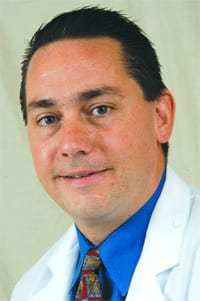Room for Improvement – New Center for Health Education at HCC Expands Opportunities
They named her Noelle.
She is the “obstetrics simulator” used by students at Holyoke Community College, and by Michelle Sherlin’s count, she’s given birth 16 times this semester, give or take a few deliveries.
Noelle has long been part of the curriculum, if you will, for students in various health and science tracks at HCC, but since she and the Health Sciences Department moved into the former Grynn & Barrett Studios building on Jarvis Avenue, she’s been playing a bigger part.
Indeed, in the new facility, Noelle has her own spacious hospital bed (a significant upgrade over her previous digs), which is visible from a larger, better-equipped screening room, from which students’ performance can be watched and assessed.
The simulator is now more mobile, said Sherlin, a registered nurse and simulation specialist within HCC’s Health & Natural Sciences Division. By that, she meant that it’s easier for Noelle to get to students and for students to get to Noelle, which means she can take part in more learning experiences — from those aforementioned deliveries to a late-term X-ray administered recently by students in the Radiologic Technology program.
In many respects, Noelle’s story captures the essence of the Health Science Division’s move into the 22,000-square-foot facility, acquired by the college in late 2012 and repurposed through a $7.6 million initiative that culminated in a ribbon cutting last fall.
There is more room, yes — considerably more room, and that’s a big part of the story. And there’s also new equipment, more than $600,000 worth it, which is usually defined with the term state-of-the-art.
But the real story, said Kathy Hankel, dean of the Health Sciences Department, is how all of the above has enhanced the learning experiences for students in a number of programs, and how it has made HCC better able to compete for students seeking entry into the region’s large and diverse healthcare sector.
“We’ve been able to greatly enhance the educational experience for our students,” she explained. “We simply have the ability to do so much more than we could before.”
When the Grynn & Barrett building went on the market in 2012, Hankel said, college administrators saw a tremendous opportunity to substantially upgrade the Health Sciences facility then housed in the Marieb Building, one of the original structures on the HCC campus.
To describe those quarters, Hankel first summoned an adjective, then an adverb for some additional effect.
“It was cramped — horribly cramped,” she explained. “We did a lot of things over there (at Marieb) with our labs and simulators, but it was so difficult for all the students to get the true benefit of the simulation and lab experience we offered because we were so cramped.”
The new Center for Health Education now houses the school’s two-year RN program, its LPN program, the Medical Assistant program, and the “Fundamentals in Health” class that has served as a feeder program for the various health disciplines.
The building houses staff offices and conference facilities, as well as a wide array of simulation rooms — all equipped to mirror what would be found in a hospital — as well as classrooms, labs, screening rooms, and more.
To say that the new quarters would retire that term ‘cramped’ is an understatement. Indeed, four months after officially moving in, Holly Martin-Peele, program chair of the Radiologic Technology Department, says she’s still having a hard time getting used to all the space.
Indeed, as she gave HCN a tour of her facilities, she referenced a classroom; a radiology simulation room, or mock X-ray room, as she termed it, which recreates what would be found in a hospital; the so-called QC area, or ‘image-critique’ facility, which also doubles as a lab and study area; and a storage room.
“Before, in the old building, we had basically a big classroom that had a couple of antique X-ray machines in back that we couldn’t find parts for anymore,” she explained. “We can do so much here.”
Sherlin concurred, and successfully quantified the improvements in addition to qualifying them.
She said there are now eight simulators in use at the facility, double the number at Marieb, and more students are using them, and in myriad ways.
“We’ve done more than 360 simulations since the beginning of September,” she explained. “Previously, that was about what we did in a year and half; we did as many simulations in one semester as we used to do in three.”
More important than those numbers are what they mean in terms of the learning experiences of those performing the simulations.
“The quality of the educational experience has grown dramatically,” she told HCN, “because students are really able to get comfortable with the technology, deepen their skills, and do a lot of critical decision making, because of simulation, that they didn’t have the ability to do before, because there was just no space.”


Comments are closed.